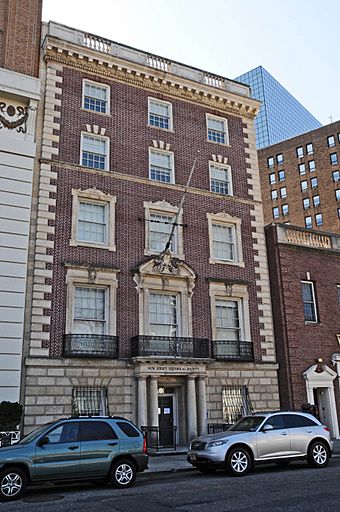New Jersey Historical Society facts for kids
|
Essex Club
|
|

Essex Club, current location of the NJ Historical Society
|
|
| Lua error in Module:Location_map at line 420: attempt to index field 'wikibase' (a nil value). | |
| Location | 52 Park Place Newark, New Jersey |
|---|---|
| Area | 0.2 acres (0.081 ha) |
| Built | 1926 |
| Architect | Guilbert and Betelle |
| Architectural style | Colonial Revival, Georgian Revival |
| NRHP reference No. | 91000110 |
Quick facts for kids Significant dates |
|
| Added to NRHP | February 22, 1991 |
The New Jersey Historical Society is a special place in Newark, New Jersey. It's both a historical society and a museum. You can find it inside what used to be the Essex Club building.
It has two floors where you can see cool exhibits, a gift shop, and a big room for talks and events. Sometimes, the Society even offers fun walking tours around Newark. It used to publish a magazine called New Jersey History, which shared interesting facts about the state's past.
You can explore exhibits on the second and third floors. If you want to read or research, the library is on the fifth floor. This used to be the Essex Club's squash courts! Anyone can visit the Society. Members get in for free, while others pay a small fee. If you plan to use the library, it's a good idea to make an appointment first. The current director is Steven Tettamanti.
Contents
History of the Society
How the Society Started
The New Jersey Historical Society began in 1845 in Trenton. Important leaders and thinkers from New Jersey helped create it. Some of these founders included Joseph C. Hornblower, Robert Gibbon Johnson, Peter D. Vroom, and William A. Whitehead.
Moving to Newark
In 1846, just one year after it started, the Society moved to Newark. It has been located there ever since. Its first home in Newark was on Market Street. Later, in 1931, it moved out of Downtown Newark to a large building on Broadway. This building was designed in a colonial style, and Louis Bamberger helped pay for it.
Returning Downtown
In 1997, the Historical Society moved back to downtown Newark. Its new home is at 52 Park Place, right next to Military Park. This building is designed in a Georgian style and was once used by the Essex Club. The famous architects Guilbert & Betelle designed it. The building itself was built in 1926. It was added to the National Register of Historic Places on February 22, 1991, because of its historical importance. When the Society moved to this new downtown spot, many more people came to visit. In fact, visits increased almost five times in the first year!
More Places to Explore
- Newark Museum
- Newark Public Library
- List of historical societies in New Jersey
- National Register of Historic Places listings in Essex County, New Jersey
- New Jersey Historical Trust
- Jewish Museum of New Jersey
- John T. Cunningham

